
Dayton 7D837A Gas Infrared Tube Heater
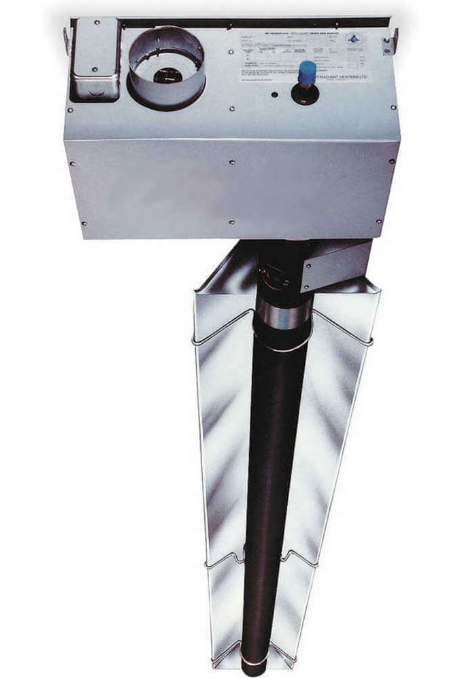
Installation
Design Considerations and Prechecks
Placement of infrared tube heaters is influenced by many factors. Aside from safety factors, considerations such as the number of elbows that are allowed, maximum vent lengths, ducting of combustion air, and combining vents are a few examples. This manual, along with national, state, and local codes, addresses these issues. All guidelines and instructions must be followed. To ensure a properly designed heating system, a heating layout should be developed for the correct placement of the burner control box, radiant tubing, venting, and combustion air intake ducts. Inspect and evaluate the mounting conditions, vent locations, gas supply, and electrical wiring. Refer to the chart below for the recommended distances for the model being installed.
Heater Installation Chart
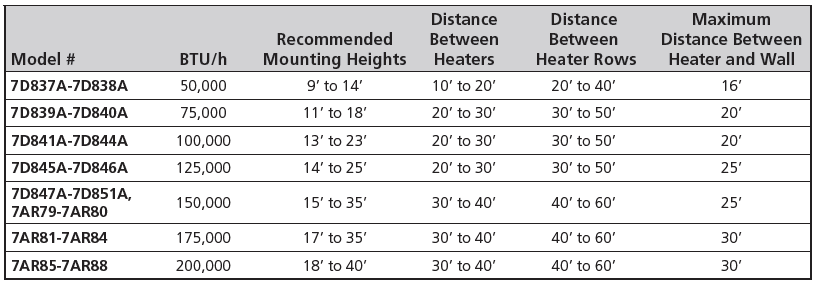
When designing an infrared radiant heating system, consider the following:
- Has the building’s heat loss been evaluated?
- Does the design meet the needs of the space?
- Have all clearance to combustible situations been observed?
- Have recommended mounting heights been observed?
- Is the supply (burner) end of the heater located where more heat is required?
- Is it best to offset the heaters and/or rotate the reflectors towards the heat zone?
- Are protective guards, side shields, ‘U’ or ‘L’ reflector covers needed?
- Does the heater require outside fresh air for combustion?
- Is the environment harsh or contaminated (requiring outside air for combustion)?
- Are chemicals or vapor a concern (requiring outside air for combustion)?
NOTE: The effective infrared surface temperature of a person or object may be diminished with wind above 5 mph. The use of adequate wind barrier(s) may be required.
NOTE: When heated, materials high in hydrocarbons (solvents, paint thinner, mineral spirits, formaldehydes, etc.) can evaporate. This may result in odors or fumes being emitted into the environment. To correct this problem, clean the area and/or introduce additional ventilation.
Heaters installed and serviced in accordance with the installation manual do not emit odors into the environment. See notice on page 28 for additional information.
Design Scenario
A tube heater system is being installed in a 70’ (L) x 40’ (W) space with 12’ ceilings. Two overhead doors are located at one end, and an equipment storage area exists on one side. The calculated heat load is 300,000 BTU/h.
Figure 2.1 • Poor Design
- Two burners (150,000 BTU/h each) are placed at one end, opposite the area of highest demand (overhead doors).
- Recommended mounting heights are not observed.
- Produces an uneven heat distribution.
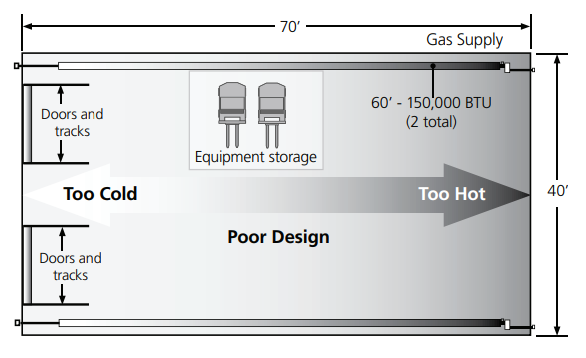
Figure 2.2 • Good Design
- Four burners (75,000 BTU/h each) are placed in each corner. Burner (hotter) ends direct heat to areas of the highest head demand.
- Recommended mounting heights observed.
- Distributes heat more evenly.
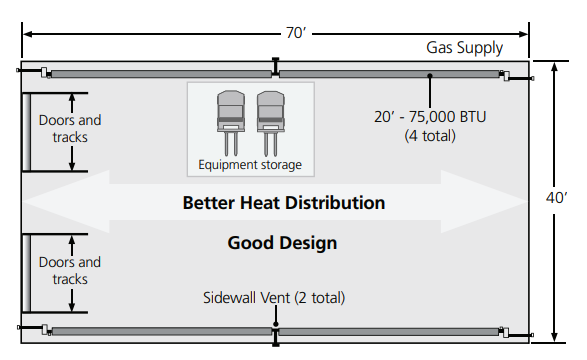
Recommended Mounting Heights
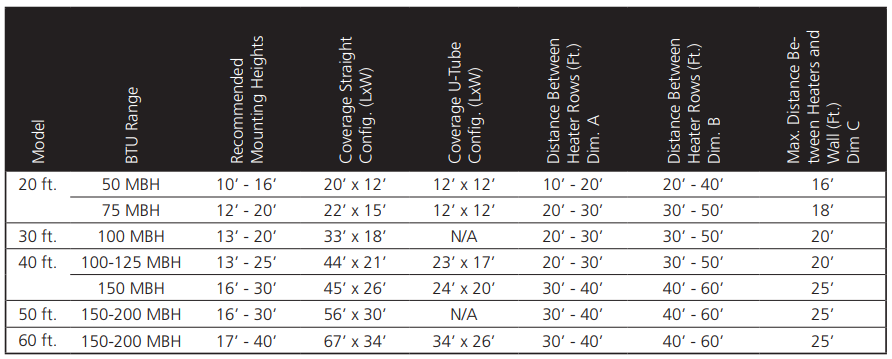
NOTE: Factory-recommended mounting heights are listed as a guideline. If infrared heaters are mounted too low or too high, they may result in heat discomfort or a lack of heat. It is generally recommended to observe the recommended mounting heights to optimize comfort conditions. However, certain applications, such as spot heating, freeze protection, outdoor patio heating, or very high ceilings, may result in the heaters being mounted outside of the factory-recommended mounting heights. Clearances to combustibles must always be maintained.
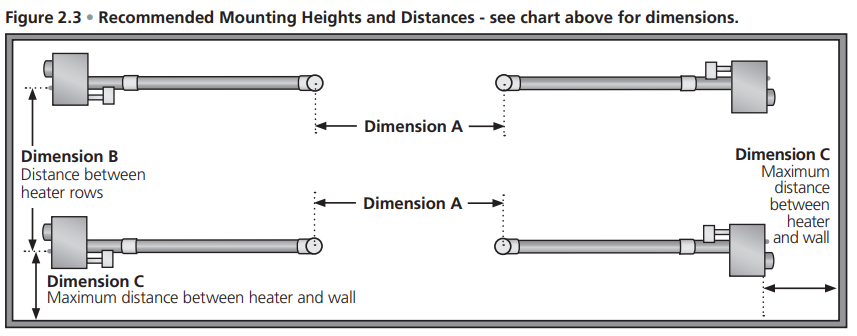
Hanger Placement and Suspension
The suspension of the heater must conform to the applicable codes referenced in the Safety section and these instructions.
- Lay radiant tubing out in the following order. Position tubes in their approximate locations. Figure 2.4.
- 10 ft. primary combustion chamber.
- Radiant emitter tubes.
IMPORTANT! 150 MBH models must use the 10 ft. titanium alloy treated combustion chamber as the first tube connected to the burner control box. The combustion chamber has an orange identification sticker located on the swaged end of the tube.
- Mark locations for hanging points. Figure 2.4 Chart.
NOTE: If the available hanging points do not allow for the recommended spacing (or if an alternative hanging method is utilized), then additional hangers may be necessary.- The spacing between the burner control box mounting brackets and the first hanger should be approximately 2’-4”.
- The space between the first two hangers placed on the first tube should be approximately 8’-10”.
- The space between hangers thereafter, one per tube, should be approximately 9’-8”.
![]() WARNING
WARNING

Failure to maintain the published clearance to combustibles may result in fire and/or explosion, property damage, serious injury, or death. Always maintain clearances and post signs where needed.
![]() WARNING
WARNING

Improper suspension of the heater may result in collapse and being crushed. Always suspend the appliance from a permanent part of the building structure that can support the total weight and force of the heater.
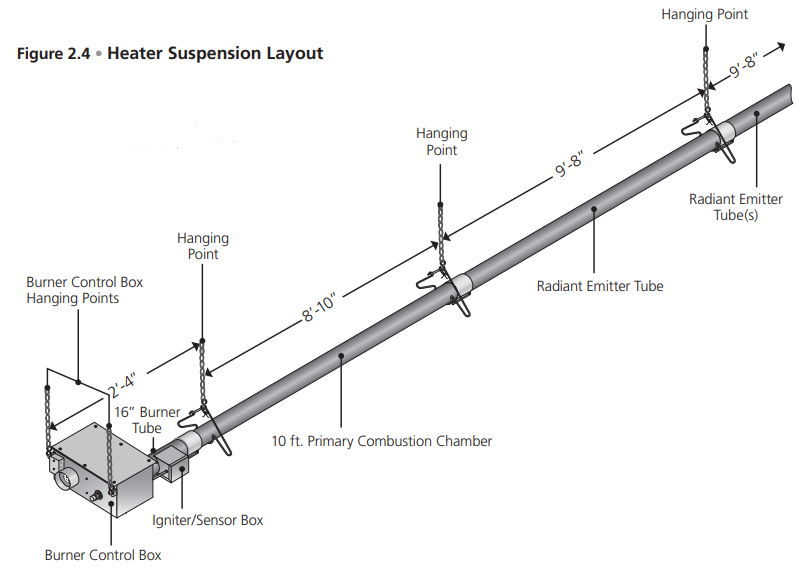
NOTE: A sticker identifying the combustion chamber(s) is located on the swaged end of the tube(s).
Heater Mounting Requirements and Weights

Heater Placement and Suspension
The suspension of the heater must conform to the applicable codes referenced in the Safety section and these instructions.
- Prepare the mounting surface. If necessary, weld blocks, drill holes, etc. Figure 2.5.
NOTE: The burner control box and radiant tubes should be in straight alignment and level. - Fasten the beam clamp, screw hook, or other type of suspension anchor to the hanging point.
- Attach and close the S-hook and #1 double-loop chain to anchor. Check that it is securely attached.
NOTE: Threaded rod and turnbuckles may be used. - Attach hangers to chains. Adjust chain lengths until radiant tubing is level and equal weight distribution is achieved.
NOTE: Chains must be straight up and down. Do not install chains at an angle, as this can result in tube warpage or separation.
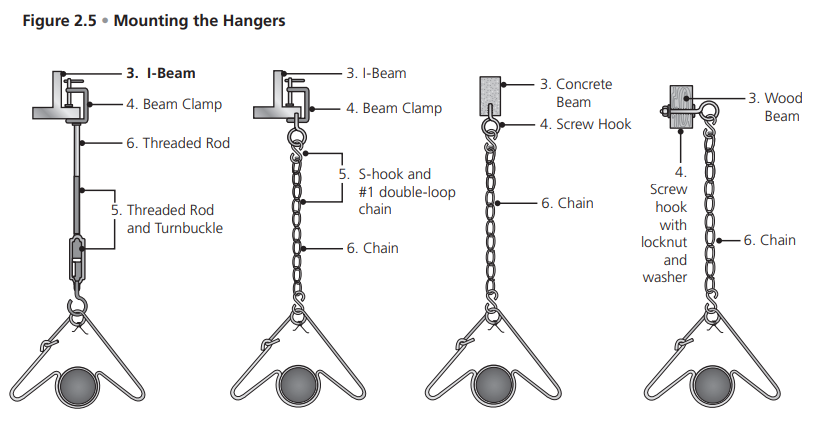
Optional U-Bend or Elbow Accessory Configuration
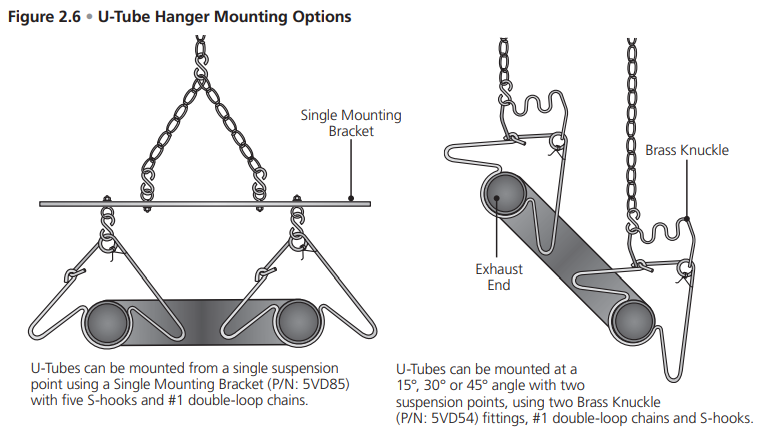
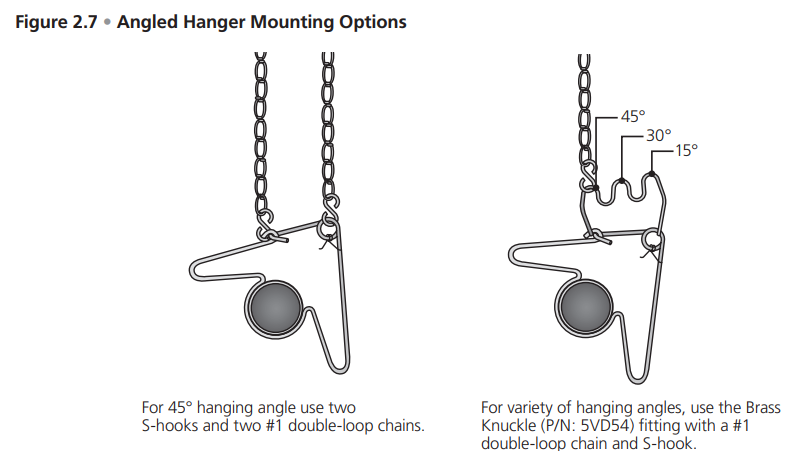
Radiant Tube Assembly
To install the radiant tubes
- Place tubes in hangers with the welded seam facing downward and the swaged end of the tube towards the exhaust end of the heater system. Figure 2.8.
Refer to Figure 2.20 on page 22 for the ube installation sequence.
- Slide the tube clamps onto the radiant tubes. Figure 2.9.
 NOTE: If the tube clamp comes apart, the spacer must be reassembled with the spacer’s concave surface facing against the radiant tube surface.
NOTE: If the tube clamp comes apart, the spacer must be reassembled with the spacer’s concave surface facing against the radiant tube surface. - Slip-fit the radiant tube sections together until tightly connected (install swaged end of each tube towards the exhaust end). NOTE: If it is difficult to mate the tubes, they may be installed incorrectly.
- Center tube clamps over the seams where two radiant tube sections connect. If necessary, rotate tube clamps so they will not interfere with the reflector end caps during expansion and contraction of the heater while operating.
- Tighten tube clamp bolts to secure. When proper compression is obtained (40-60 ft-lbs. torque), the tube seam will create a visible mark on the tube clamp.
NOTE: Excessive torque may damage the tube clamp. - Determine the location of the burner control box and note the placement of the mounting chains.
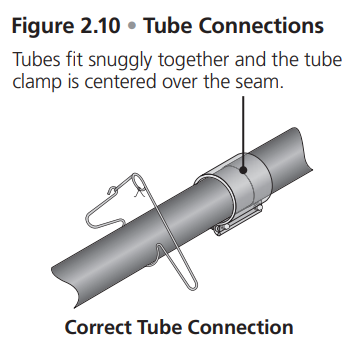
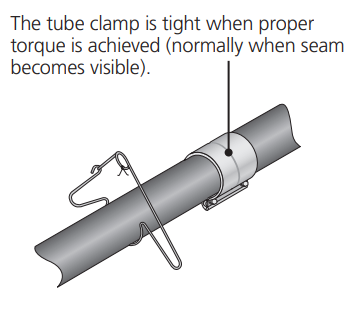
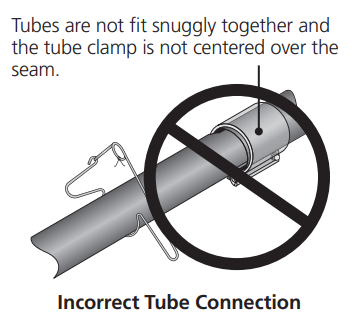
A 180-degree U-bend or 90-degree accessory fitting may be installed in the radiant tube heater system. Refer to the chart on page 17 for minimum distance requirements from the burner control box.
When installing a U-bend or Elbow Accessory Fitting:
- The top clearance of an uncovered (no reflector) U-bend or elbow accessory fitting to combustibles is 18”.
- If operating the heater unvented, separate the intake air to the heater from its exhaust products a minimum of 4’; further separation may be necessary. Combustion air may also be supplied.
- A maximum of one 180° U-bend or two 90° elbows can be installed on a heater.
- Omit one 36” section of turbulator baffle. Refer to the affle Assembly section.
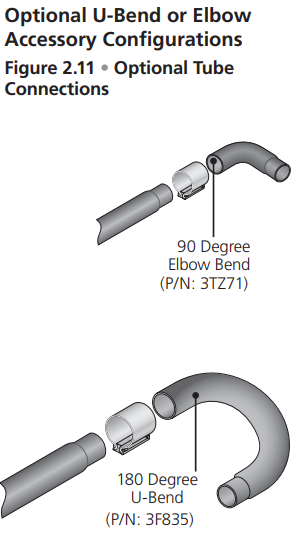
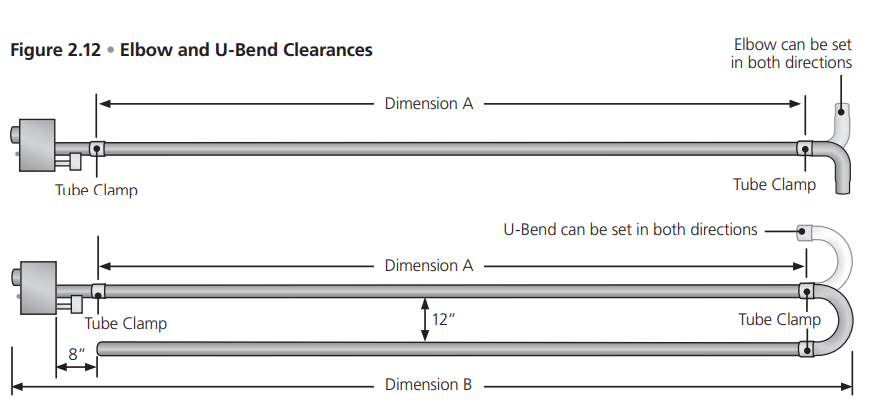
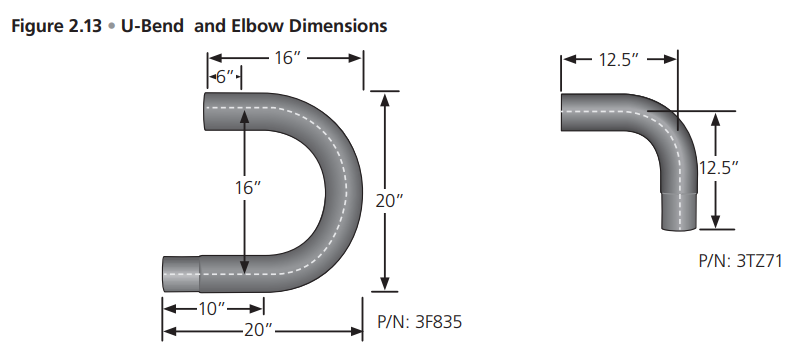
Minimum Distance from Burner Control Box to U-Bend or Elbow Accessory
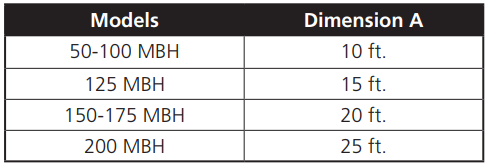
Overall Dimensions for Heaters Configured with U-Bend (P/N: 3F835)
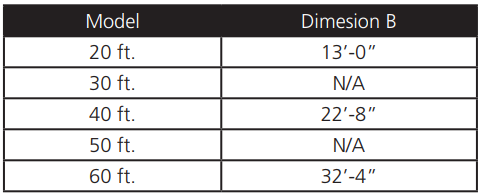
Burner Control Box Suspension
Suspending the burner control box must be done in accordance with applicable codes listed in the Safety section and these instructions. The burner control box must be in straight alignment with the radiant tubes and level.
- Determine the mounting chain locations for hanging the burner control box.
- Fasten the beam clamp, screw hook, or other type of suspension anchor to the hanging point.
- Attach and close the S-hook and #1 double-loop chain to the anchor. Check that it is securely connected.
- Attach chain assemblies and S-hooks to mounting brackets on the burner control box. Adjust chain lengths until level and in straight alignment with the radiant tubes. The burner sight glass will be visible from the floor.

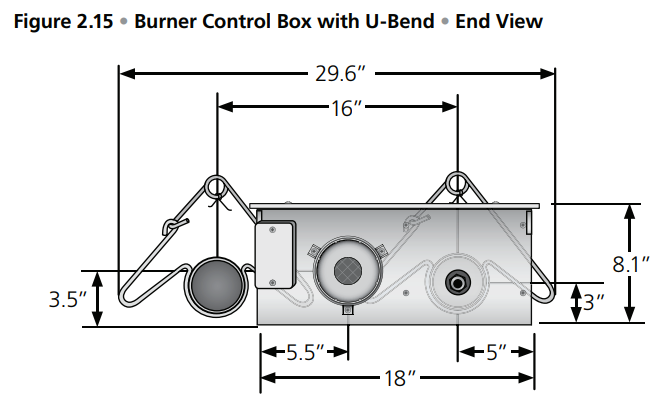
Reflector Assembly
To install the reflectors:
- Attach the reflector center supports to the radiant tubes.
- Slide each reflector section through the hangers and adjust the reflector tension spring into the V-groove on the top of the reflector. The reflectors should overlap approximately 4”.
- To prevent the reflectors from shifting, secure the reflector sections together using sheet metal screws except at the expansion joint. Figure 2.18. NOTE: Installer to provide sheet metal screws.
- Attach reflector end caps, with polished side inward, to each end of the reflector run. Reflectors and reflector accessories direct infrared energy to the floor level. The reflector assembly depends on the heater configuration, proximity to combustibles, and the space surrounding the heater.
Before you begin assembly, determine if the use of reflector accessories is necessary. Figure 2.18.
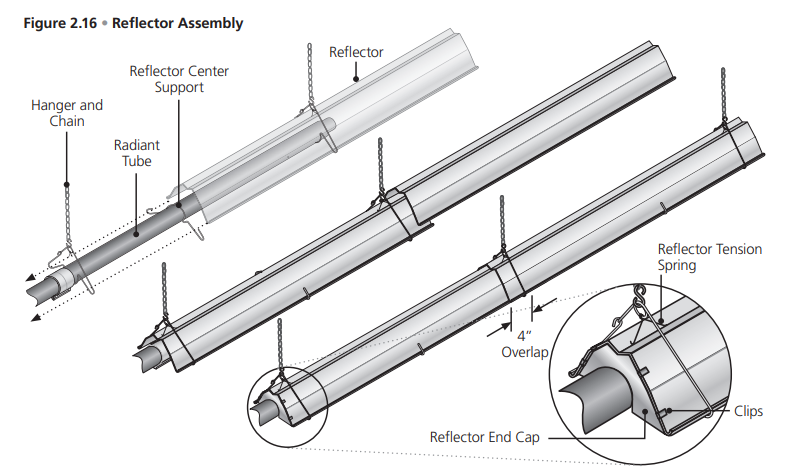
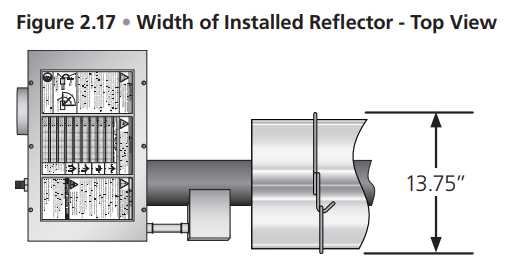
Common Optional Accessories

Additional accessory options are available in the W.W. Grainger catalog.
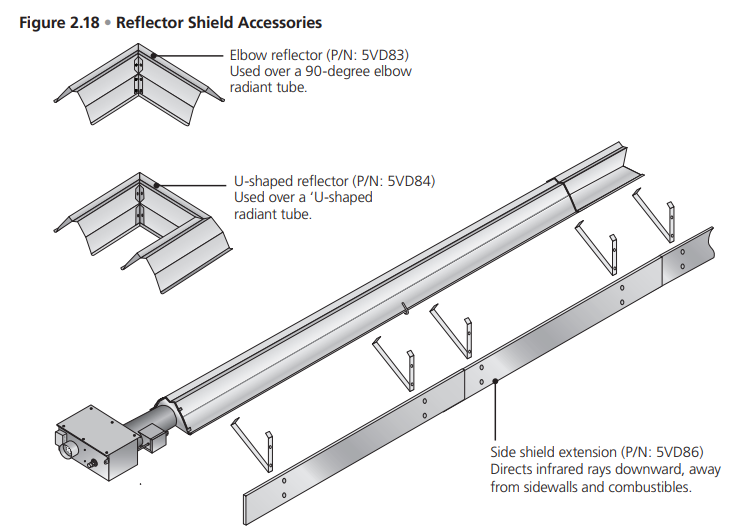
Baffle Assembly and Placement
To assemble the baffles
NOTE: Baffles may be inserted into the tube while being assembled.
- Determine the number of baffles needed for your model number. Remove one 36” baffle section if the heater is installed with an elbow or U-bend accessory.
- Install the baffle tabs at a 90° angle to the baffle keyhole. Figure 2.19.
- Insert one baffle tab into the keyhole and slide completely to one side until both baffle tabs appear in the keyhole.
- Adjust the tabs to the center of the keyhole and rotate the baffle 90° to lock the baffle sections together.
- Repeat this process with the remaining baffle sections to complete the assembly.
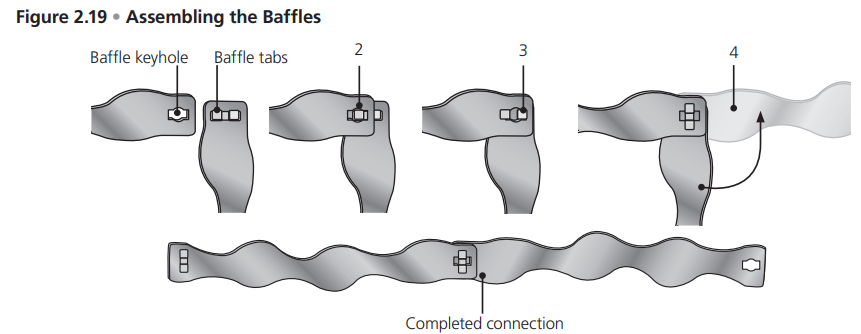
To insert the baffles
- Insert baffles with the keyhole end first.
- Rotate the baffle assembly so that it is in the vertical position.
- Slide the baffle assembly into the last radiant tube section, furthest from the burner control box.
NOTE: Baffle assemblies longer than 10’ will continue to be fed into the next tube section.
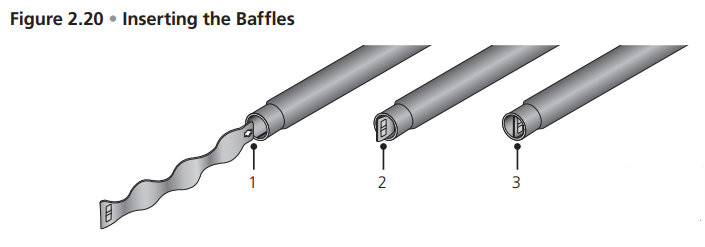
IMPORTANT: Baffle assembly must be flush with the end of the last tube section and in the vertical position.
Final Heater Assembly
NOTICE
Different inputs and models utilize different baffle lengths. Remove all enclosed baffle sections from the box and retain them with the applicable heater. Reference shipping label for proper baffle size. Each 36” baffle section must be assembled with other baffles and placed in the radiant tube section furthest from the burner. Important: Omit one section of the baffle if the heater is configured with a U-bend or Elbow accessory fitting.
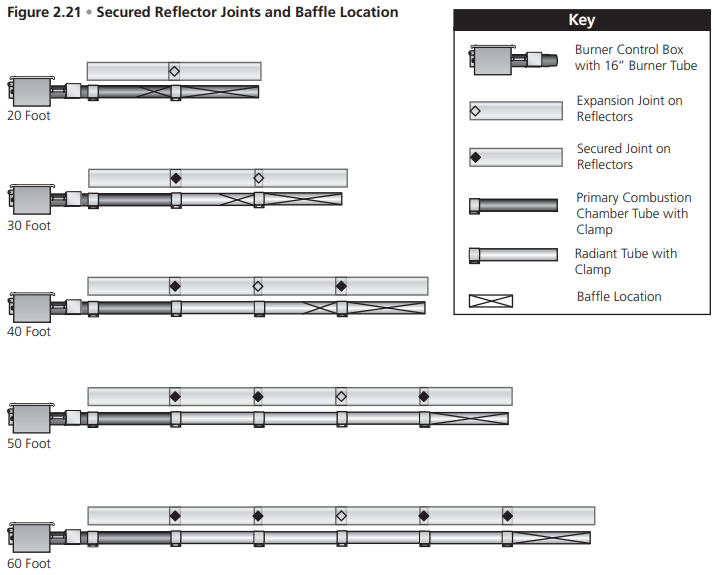
Venting
![]() WARNING
WARNING
Insufficient ventilation and/or improperly sealed vents may release gas into the building, which could result in health problems, carbon monoxide poisoning, or death.
Improper venting may result in fire, explosion, injury, or death. Seal vent pipes with high-temperature sealant and three (3) #8 sheet metal screws. Vent enclosed spaces and buildings according to the guidelines in this manual and applicable national, state, provincial, and local codes.
The heating system may operate either vented or unvented (see page 27). Venting can terminate through the sidewall (horizontal) or the roof (vertical) and can be individually or commonly vented.
Follow these guidelines and all applicable codes for all models, prior to installing vent material. Local codes may vary. In the absence of local codes, refer to the National Fuel Code ANSI Z223.1 (NFPA 54), latest edition, or the National Standards of Canada.
Venting Requirements
- 4” single-wall galvanized steel vent pipe or Dura/Connect single-wall flexible exhaust vent must be used.
- Seal the single-wall vent with high-temperature sealant and three (3) #8 sheet metal screws.
- Single-wall galvanized vent pipe must be insulated in cold environments.
- Do not use more than two 90° elbows in the exhaust vent.
- To maintain clearances to combustibles, the use of an approved wall or roof thimble and double-wall Type B-vent is required for the portion of vent pipe that runs through combustible material in the building wall or roof (see figures 2.22 & 2.23).
- The maximum vent length is 20’.
Vent Assembly
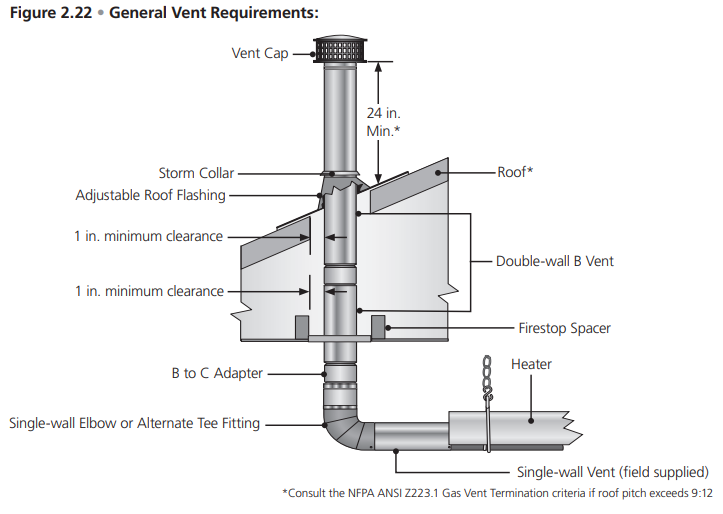
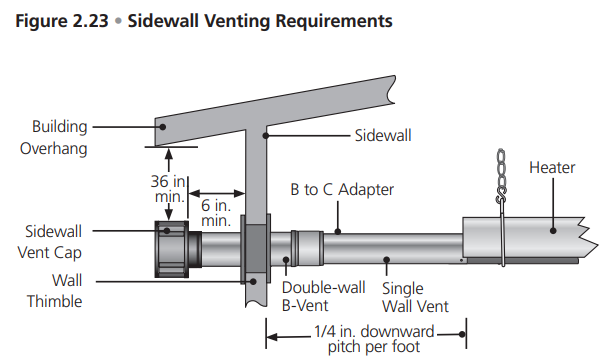
Sidewall Venting Guidelines
- To prevent moisture from entering the heater system, slope the vent pipe down toward the outlet 1/4” per foot of length. Do not pitch the heater.
- Vent must extend beyond any combustible overhang.
Vent Termination
- Vent must terminate a minimum of 4’ (1.2m) below, 4’ (1.2m) horizontally from or 12” (30 cm) above any window or door that may be opened, and a gravity air inlet into the building.
- Vent must terminate a minimum of 3’ (.9m) above any forced air inlet that is located within 10’ (3.1m).
- The bottom of the vent terminal must be located a minimum of 12” (30 cm.) above grade level and must extend beyond any combustible overhang. Vents adjacent to public walkways must terminate a minimum a 7’ (2.1 m) above grade level.
- The vent cap must be a minimum of 6’ (15.2 cm) from the sidewall of the building.
- The vent terminal must be installed to prevent blockage by snow and protect building materials from degradation by flue gases.
- Vents must extend beyond any combustible or be a minimum of 36” below a combustible overhang.
Roof Venting
Guidelines:
- Separate the air intake duct from the vent pipe a minimum of 4’ (1.2 m) by placing the vent pipes higher than the adjacent air intake duct.
- Venting may utilize a standard B-vent cap.
- The vent terminal must extend a minimum of 2’ (.6 m) above the roof.
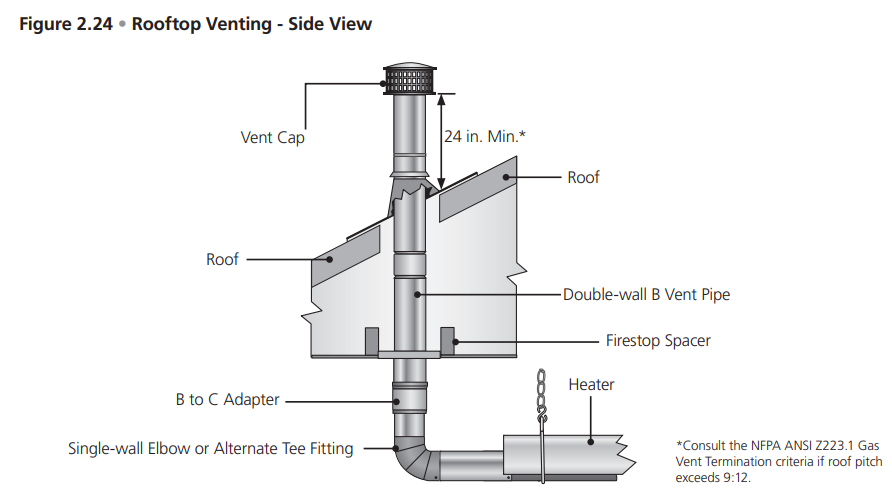
Vent Requirements
Common Venting
- A dual exhaust assembly (P/N: 3F817) must be used when joining two heaters to a common vent so that byproducts of one heater do not flow into the adjoining vent of the other heater.
- 6” diameter double-wall B-vent and 6” vent cap must be used.
- Common vented heaters must be controlled with the same thermostat. Do not operate individually.

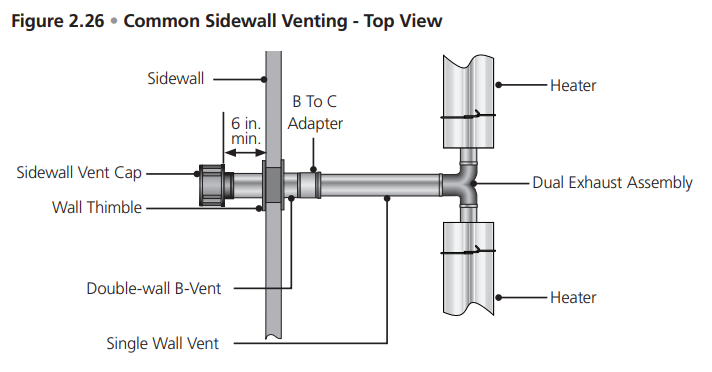
Optional Unvented Operation
When installing in an unvented configuration:
- A factory-supplied vent cap/diffuser (P/N: 3F839) must be used.
- Ventilation of the space is required to dilute the by-products of combustion. Sufficient displacement of fresh air intake and exhaust byproducts must be provided.
- The minimum clearance between the air intake and the exhaust terminal is 4’. NOTE: When installing in a U-bend configuration, use caution to separate vent gases from heater intake.
- A minimum positive air displacement (movement) of 4 ft3/1000 BTU/h input of installed heaters is required.
NOTE: Gravity or mechanical means may be used to accomplish the air displacement. Local codes may require that the mechanical exhaust system be interlocked with the electrical supply line to the heaters, enabling both to function simultaneously. - The use of combustion air intake is recommended.

![]() WARNING
WARNING
Not for residential use. The use of unvented tube heaters in residential indoor spaces may result in property damage, serious injury, or death. Use unvented operation in commercial and industrial installations with proper ventilation rates only.
Operation
![]() WARNING
WARNING

This heater is not equipped with a pilot ignition system. Do not attempt to light the system manually.
LIGHTING PROCEDURES
- Verify that the service lid is secured.
- Open (turn on) the gas supply to the heater.
- Close (turn on) the electrical circuit (typically the thermostat).
- If the heater fails to light, turn off the gas, open the electrical circuit (set thermostat to lowest setting or off). Wait five (5) minutes before repeating the above steps.
SHUTDOWN PROCEDURES
- Open (turn off) the electrical circuit.
- Close (turn off) the gas supply to the heater.
- Wait five (5) minutes before relighting the heater.
Sequence of Operation
Starting Circuit
Upon a call for heat, the fan is energized. Once operational static pressure is achieved, the differential switch will close, initiating the ignition sequence. After a 5-second delay, the hot surface igniter is energized for 45 seconds, and the control allows the gas valve to open. The trial for ignition is 8 seconds. If flame sense is not established within 8.5 seconds, the heater will attempt two (2) additional ignition sequences before proceeding to soft lockout. Soft lockout automatically retries after one (1) hour, or the control can be reset by briefly interrupting the power source.
Running Circuit
After ignition, the flame rod monitors the burner flame. If the source of flame is lost, the control immediately acts to reignite the gas-air mixture (identical to the starting sequence). If flame sense is not established within 8.5 seconds, the heater will attempt two (2) additional ignition sequences before proceeding to soft lockout. The control can be reset by briefly interrupting the power source.
Maintenance
Routine Inspection
At least once per year, the heating system should be inspected and serviced by trained gas installation and service personnel only. This inspection should be performed at the beginning of the heating season to ensure that all heater components are in proper working order and that the heating system operates at peak performance. Particular attention should be paid to the following items.
- Blower Motor: Annual oiling of the blower motor with SAE 20 oil will extend bearing life significantly. Ensure that the squirrel cage in the blower is kept clean. If dirt becomes a problem, installation of outside air intake ducts for combustion is recommended.
- Vent pipe system: Check the outside termination and the connections at the heater. Inspect the vent exhausts for leakage, damage, fatigue, corrosion, and obstructions. If dirt becomes a problem, installation of outside air intake ducts for combustion is recommended.
- Combustion air intake system (when applicable): Check for blockage and/or leakage. Check the outside termination and the connection at the heater.
- Heat exchangers: Check the integrity of the heat exchangers. Replace if there are signs of structural failure. Check for corrosion and/or buildup within the tube exchanger passageways.
- Burner: Check for proper ignition, burner flame, and flame sense. Flame should extend directly outward from the burner without floating or lifting.
- Wiring: Check electrical connections for tightness and/or corrosion. Check wires for damage.
- Gas Connection: Inspect the integrity of the gas connection to the heater. Check for leaks, damage, fatigue, or corrosion. Do not operate if repairs are necessary, and turn off the gas supply to the heater. Contact service personnel.
- Reflectors: To maintain effective infrared heating, always keep both sides of the reflector clean. Maintenance can vary significantly depending on the environment. Dirt and dust can be vacuumed or wiped with a soap and water solution. Use metal polish if the reflectors are severely dirty.
Contact service personnel if repairs are necessary. Do not operate the nit.
Troubleshooting Guide
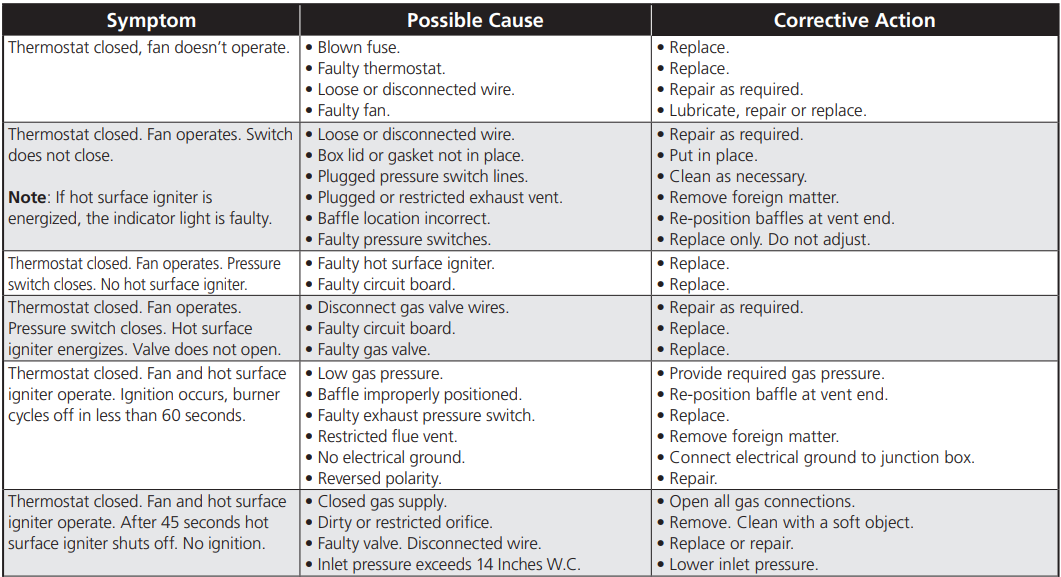

Limited Warranty
Dayton One-Year Limited Warranty. Dayton Radiant Tube Heaters, Models 7D837A through 7D849A, 7D851A, 7AR79 through 7AR88 covered in this manual, are warranted by Dayton Electric Mfg. Co. (Dayton) to the original user against defects in workmanship or materials under normal use for one year after the date of purchase. Any part which is determined to be defective in material or workmanship and returned to an authorized service location, as Dayton designates, shipping costs prepaid, will be, as the exclusive remedy, repaired or replaced at Dayton’s option. For limited warranty claim procedures, see PROMPT DISPOSITION below. This limited warranty gives purchasers specific legal rights which vary from jurisdiction to jurisdiction.
Additional Limited Warranty. In addition to the above-mentioned one-year warranty, Dayton warrants the original purchaser an additional 4-year extension on the combustion chamber, radiant tubes, and stainless steel burner. This 4-year extension excludes electrical/purchased components.
General Conditions. Dayton will not be responsible for labor charges for the analysis of a defective condition of the heater or for the installation of replacement parts. The warranties provided herein will not apply if the input of the heater exceeds the rated input at time of manufacturing or if the heater in the judgement of the Company has been subjected to misuse, excessive dust, improper conversion, negligence, accident, corrosive atmospheres, excessive thermal shock, excessive vibration, physical damage to the heater, alterations by unauthorized service personnel, operation contrary to Dayton’s instructions or if the serial number has been altered, defaced or removed. Dayton shall not be liable for any default or delay in the performance of these warranties caused by contingency beyond its control, including war, government restriction or restraints, strikes, fire, flood, short or reduced supply of raw materials, or parts. The warranties herein shall be null and void if the heater is not installed by a competent heating contractor and/ or if the heater is not installed according to Dayton’s instructions, normal industry practices, and/or if the heater is not maintained and repaired according to Dayton’s instructions. Normal product degradation and wear (rust, oxidation, etc.) does not constitute a material defect and an applicable warranty claim.
Limitation of Liability. To the extent allowable under applicable law, Dayton’s liability for consequential and incidental damages is expressly disclaimed. Dayton’s liability in all events is limited to and shall not exceed the purchase price paid. Warranty Disclaimer. Dayton has made a diligent effort to provide product information and illustrate the products in this literature accurately; however, such information and illustrations are for the sole purpose of identification, and do not express or imply a warranty that the products are merchantable, or fit for a particular purpose, or that the products will necessarily conform to the illustrations or descriptions. Except as provided below, no warranty or affirmation of fact, expressed or implied, other than as stated in the “LIMITED WARRANTY” above, is made or authorized by Dayton.
Product Suitability. Many jurisdictions have codes and regulations governing sales, construction, installation, and/or use of products for certain purposes, which may vary from those in neighboring areas. While Dayton attempts to ensure that its products comply with as many codes, it cannot guarantee compliance, nd cannot be responsible for how the product is installed or used. Before purchasing and use of a product, review the product applications and all applicable national and local codes and regulations, and be sure that the product, installation, and use will comply with them.
Certain aspects of disclaimers do not apply to consumer products: e.g., (a) some jurisdictions do not allow the exclusion or limitation of incidental or consequential damages, so the above limitation or exclusion may not apply to you: (b) also, some jurisdictions do not allow a limitation on how long an implied warranty lasts, consequently the above limitation may not apply to you: and (c) by law, during the period of this limited warranty, any implied warranties of implied merchantability or fitness for a particular purpose applicable to consumer products purchased by consumers, may not be excluded or otherwise disclaimed. Prompt Disposition. Dayton will make a good faith effort for prompt correction or other adjustment with respect to any product which proves to be defective within the limited warranty. For any product believed to be defective within the limited warranty, first write or call the dealer from whom the product was purchased. The dealer will give additional directions. If unable to resolve satisfactorily, write to Dayton at the address below, giving dealer’s name, address, date, and number of dealer’s invoice, and describe the nature of the defect. Title and risk of loss pass to the buyer on delivery to the common carrier. If the product was damaged in transit to you, file a claim with the carrier.
For more manuals by Dayton, visit ManualsLibraryy
Dayton 7D837A Gas Infrared Tube Heater- FAQs
Q1. How do I operate a gas infrared tube heater?
Turn on the gas supply, set the thermostat, and ensure proper ignition. Always follow the manufacturer’s instructions for safe operation.
Q2. How can I tell if my infrared heater is working?
If the tube glows red and you feel direct radiant warmth within minutes, your heater is functioning correctly.
Q3. How does a gas infrared tube heater work?
It burns natural gas or propane to heat a steel tube, which then radiates infrared energy to warm surfaces and objects directly.
Q4. Do infrared tube heaters need ventilation?
Yes. Proper ventilation is required to ensure safe combustion and to prevent buildup of harmful gases.
Q5. Is it safe to run an infrared heater all the time?
Most units are designed with safety features like overheat protection, but continuous use should always follow the manufacturer’s guidelines.
Q6. How long does it take an infrared heater to warm a room?
You’ll feel warmth within 3–10 minutes, though heating the entire space may take longer depending on insulation.
Q7. What is the efficiency of a gas infrared tube heater?
High-efficiency models can achieve up to 93% thermal efficiency, making them cost-effective for large spaces.
Q8. How long do infrared heaters last?
With proper care, infrared heaters can last 20 years or more due to their durable design and advanced heating technology.
Q9. Are gas infrared heaters safe?
Yes, when installed correctly with ventilation. They produce radiant heat without open flames and come with built-in safety systems.
Q10. What are common problems with infrared heaters?
Issues may include poor placement, inadequate insulation, or a heater that’s not powerful enough for the space.

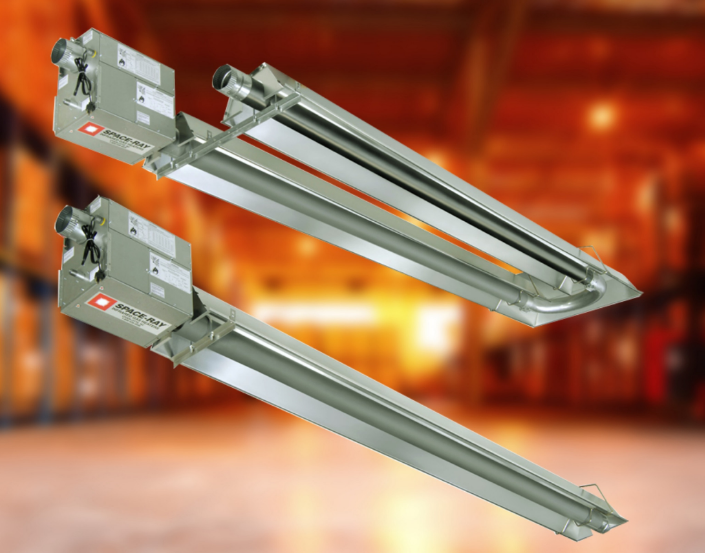
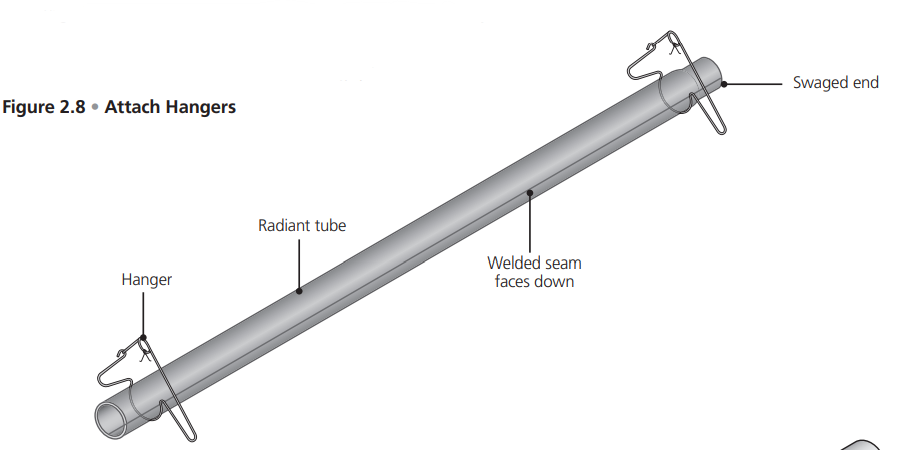
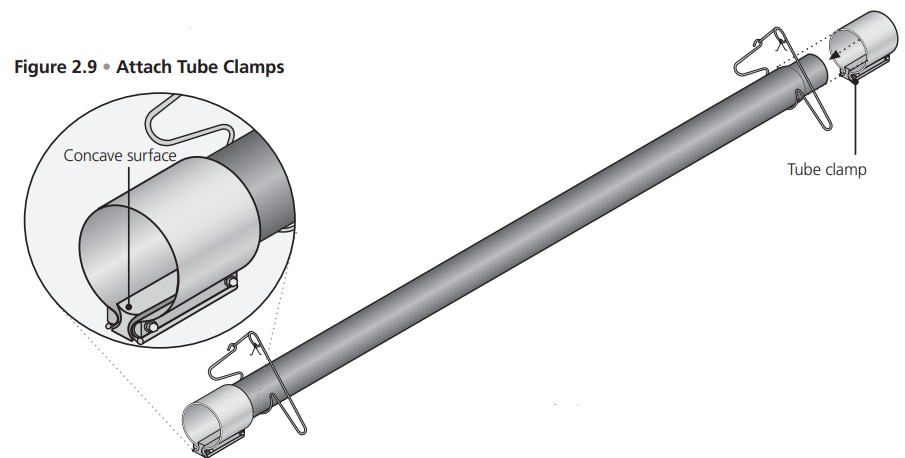 NOTE: If the tube clamp comes apart, the spacer must be reassembled with the spacer’s concave surface facing against the radiant tube surface.
NOTE: If the tube clamp comes apart, the spacer must be reassembled with the spacer’s concave surface facing against the radiant tube surface.